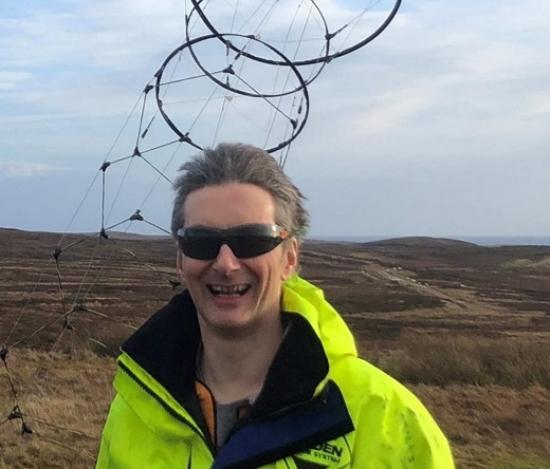Kite Power Reaches New Heights In Shetland
31st August 2021

A Lewis man who recently moved to Shetland has been awarded funding from Highlands and Islands Enterprise (HIE) to help make kite energy a reality.
Rod Read set up his company, Windswept and Interesting Ltd in 2012 when he started developing kite turbines. The lightweight airborne wind energy system was originally aimed at eco travellers, electric vehicles and the agricultural industry.
Generating power through kites is a relatively new concept but one that is now gathering global interest as a scalable carbon-neutral power option for the future.
His innovative turbine system uses wind to lift a kite high in the air and connects to the hoops of a rotary kite, which turns a ground-based generator to produce power.
Rod has already produced prototypes and is now increasing the scale and scope from one that produces 1.5kW to a 10kW improved version of the concept.
He has been working with research partners and academia including the University of Strathclyde to develop the system. More recently, he secured £40,000 from HIE for the £190,000 first phase of the project.
The funding will allow Rod to build on this research and development and focus on planning for modelling, design, testing and data capturing. It is expected that two jobs will be created over the next three years.
Rod is keen to test the boundaries of the kite turbines in Shetland's strong wind speeds and once the initial work is done, hopes to have funding in place to perform the phase two prototyping. After that, he hopes to be in a good position to start production or go even larger.
The business is one of around 40 companies worldwide dedicated to kite energy. Rod's kite turbine can easily fit into a small electric vehicle and can also be used to charge the car, enabling it to be energy independent. A portable low-cost kite wind turbine could appeal to crofters, eco travellers, campers and farm workers.
Shetland provides room for Rod to expand his kite turbines using a larger testing area. Plans are being developed to use parts of Scatsta Airport, which closed to flights in 2019, for testing the kite turbine's electricity production and economic potential.
John MacKenzie, senior development manager at HIE, said:"This is a really exciting project and one that could potentially benefit remote communities and create more jobs in our region. The innovative energy system is low-cost and uses less carbon than other renewable energy options. The mechanisms behind kite turbines are new and the system is an emerging technology, which could make the Highlands and Islands a leader in this new field of technology."
Rod and his family moved to Shetland last year after his wife, Kirsty became the new medical director in Shetland. He said:"The whole idea with kite power is about making lightweight and scalable systems, which can fly in stronger winds at higher altitudes. The operational capacity of kite turbines to scale is not yet known, which is the biggest research and development challenge faced in bringing the product to market and this is what this project aims to address.
“Shetland offers a fantastic opportunity to prove durability and reliability in higher wind speeds. We are really pleased with the funding we have received from HIE to support our project."
The company was successful in securing Shell’s Gamechanger funding and has also been awarded funding from Shetland Islands Council.
Related Businesses
Related Articles
How Development and Innovation Have Been Supported in the Highlands & Islands Over the Past 60 Years
For 60 years, the Highlands and Islands have been the focus of one of the UK's most distinctive long-term regional development efforts. Since the creation of the Highlands and Islands Development Board (HIDB) in 1965—and its evolution into Highlands and Islands Enterprise (HIE) in 1991.
Planning consent granted for Inverness Campus
Highlands and Islands Enterprise (HIE) has been granted planning permission in principle to progress the second and final phase of development at Inverness Campus. The consent is subject to a Section 75 agreement being finalised between HIE and The Highland Council.Island Business Resilience Fund expansion
Businesses affected by ferry disruption in Coll, Tiree, the Small Isles, Mull, Iona, Ulva, Barra, Vatersay, Islay and Jura can now access financial support. The £4.4 million Islands Business Resilience Fund (IBRF) is expanding to support more businesses experiencing economic impacts linked to travel issues.What the NC500 Research Projects Are Designed to Do - and Why They Matter for the Highlands
As the North Coast 500 approaches its tenth anniversary, it has become one of Scotland's most well-known tourism success stories. The 516-mile loop around the far north of the Highlands has been celebrated internationally, marketed as a world-class road trip, and credited with transforming visitor numbers in some of Scotland’s most remote areas.Workforce North event spotlights Highland economy
EMPLOYERS and educators from across the Highlands have gathered to hear how a new initiative is aiming to transform the region's economy. Workforce North - A Call to Action brought together business leaders and teachers from primary and secondary schools from across the Highland Council area with a wide range of partners geared towards education, learning and skills development at Strathpeffer Pavillion.
Tartan challenge for UHI students offers £1,500 prize
Students from across the University of the Highlands and Islands (UHI) partnership have been challenged to design a tartan and be in with a chance of winning a £1,500 cash prize. Highlands and Islands Enterprise (HIE) has launched THE COMPETITION to mark 60 years since the regional development agency (then named Highlands and Islands Development Board) was established in November 1965.
The Rural AI Roadshow - How AI can help your rural business thrive
Scotland's enterprise agencies (Scottish Enterprise, Highlands and Islands Enterprise, South of Scotland Enterprise) The Scottish AI Alliance and The Data Lab have joined forces to plan and deliver an inspiring and educational Rural AI Roadshow. There will be three, one day, Rural AI Roadshow conferences taking place across Scotland in January 2026.
Digital and AI innovation round-up for November
Scotland's digital future is accelerating, with AI and tech innovation transforming businesses. In this blog, HIE's Theresa Swayne shares November insights on funding, leadership, and how organisations can harness technology to stay ahead.
Reflections from SEWF Rural: global lessons for the Highlands and Islands social impact economy
As we mark 60 years since the region's economic and community development agency was established, it's timely to reflect on the global aspects of our work on shaping rural futures. The recent Social Enterprise World Forum (SEWF) Rural Gathering in Sabah, Malaysia, welcomed changemakers from Australia, Ireland, India, Canada.
Scottish Entrepreneurial Ecosystem Guide - FREE To Download
Scottish Enterprise's Entrepreneurial Ecosystem Guide provides an overview of more than 150 organisations that support new and growing companies in Scotland. The guide includes incubators, accelerators, specialist industry programmes, co-working spaces and networking organisations.

